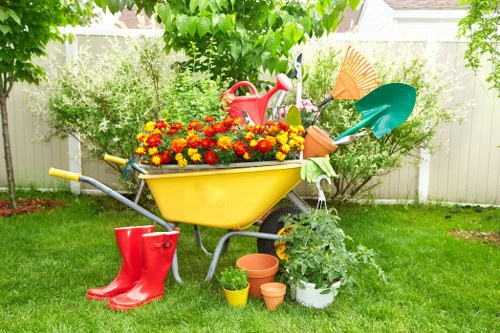Mastering Hedge Trimming in Lucas Gardener
Introduction to Hedge Trimming

Maintaining beautiful hedges is essential for a well-kept garden. Hedge trimming in Lucas Gardener plays a crucial role in enhancing the aesthetic appeal and health of your garden plants. Regular trimming not only keeps the hedges in shape but also promotes healthy growth.
Whether you are a seasoned gardener or a beginner, understanding the basics of hedge trimming can make a significant difference. Proper techniques can lead to lush, vibrant hedges that serve as stunning backdrops or privacy screens in your outdoor space.
In this comprehensive guide, we will explore the best practices for hedge trimming, tools you will need, and the benefits it brings to your garden. By the end of this article, you'll be equipped with the knowledge to keep your hedges looking their best all year round.
Essential Tools for Hedge Trimming

To achieve precise and clean cuts, having the right tools is paramount. Here are some essential tools for hedge trimming in Lucas Gardener:
- Hedge Trimmers: Electric or gas-powered, these are ideal for trimming larger hedges efficiently.
- Pruning Shears: Perfect for detailed work and shaping smaller sections.
- Loppers: Useful for cutting through thicker branches that are beyond the capacity of standard shears.
- Gloves and Protective Gear: To ensure safety while trimming.
Investing in high-quality tools will not only make the trimming process easier but also help in maintaining the health of your hedges by preventing damage.
When to Trim Your Hedges

Timing is crucial when it comes to hedge trimming. The best time to trim your hedges in Lucas Gardener depends on the type of hedge you have:
- Evergreen Hedges: Trim in late spring or early summer to promote dense growth.
- Deciduous Hedges: Best trimmed in late winter or early spring before new growth begins.
- Flowering Hedges: Trim after flowering to avoid cutting off next season's blooms.
Regular trimming schedules, aligned with the growth cycles of your hedges, will ensure they remain healthy and visually appealing.
Techniques for Effective Hedge Trimming

Applying the right trimming techniques can make a significant difference in the appearance and health of your hedges. Here are some key techniques to consider:
Shearing
Shearing creates a uniform and formal appearance by cutting the hedge from the outside inwards. This method is ideal for creating geometric shapes and maintaining a tidy look.
Natural Trimming
Natural trimming involves trimming the hedge in a way that allows for a more organic and flowing shape. This technique is perfect for informal garden settings where a more relaxed appearance is desired.
Maintaining Height and Shape
Consistently maintaining the height and shape of your hedges prevents overgrowth and ensures they complement your garden's overall design. Use guiding stakes or strings to help achieve straight lines and symmetrical forms.
The Benefits of Regular Hedge Trimming

Regular hedge trimming offers numerous benefits that contribute to the overall health and beauty of your garden:
- Enhanced Aesthetics: Well-trimmed hedges add structure and beauty to your garden.
- Promotes Healthy Growth: Removing dead or diseased branches encourages new, healthy growth.
- Prevents Pests and Diseases: Trimming reduces the risk of pests and diseases by improving air circulation.
- Increases Privacy: Maintaining dense hedges ensures effective privacy screens around your property.
By incorporating regular trimming into your gardening routine, you can enjoy these benefits year-round.
Choosing the Right Type of Hedges
Selecting the appropriate type of hedge is the first step towards successful hedge trimming in Lucas Gardener. Consider factors such as climate, soil type, and desired height when choosing hedge plants. Popular choices include:
- Boxwood: Ideal for formal gardens with dense, evergreen foliage.
- Privet: Fast-growing and versatile, suitable for both formal and informal settings.
- Laurel: Offers thick, glossy leaves and is excellent for privacy hedges.
- Yew: Tolerant of heavy pruning and provides a rich, green appearance.
Understanding the growth habits and maintenance requirements of different hedge types will help you make informed decisions and achieve the best results.
Maintaining Hedge Health
Healthy hedges are the foundation of a beautiful garden. Here are some tips to maintain the health of your hedges:
Proper Watering
Ensure your hedges receive adequate water, especially during dry periods. Overwatering can lead to root rot, while underwatering may cause the plants to become stressed and susceptible to diseases.
Fertilization
Regularly fertilize your hedges to provide essential nutrients. Use a balanced fertilizer to promote robust growth and vibrant foliage.
Pruning Techniques
Adopt proper pruning techniques to avoid damaging the plants. Make clean cuts at the right angles and avoid removing more than one-third of the hedge at a time.
Seasonal Hedge Trimming Tips
Each season presents unique challenges and opportunities for hedge trimming. Here are some seasonal tips to keep your hedges in top condition:
- Spring: Prune flowering hedges after blooms fade and prepare for new growth.
- Summer: Trim hedges regularly to maintain shape and encourage bushier growth.
- Autumn: Remove any dead or damaged branches and prepare hedges for the winter months.
- Winter: Conduct a final trim for evergreen hedges before heavy snowfall to prevent breakage.
Adapting your trimming practices to the changing seasons will ensure your hedges remain healthy and beautiful throughout the year.
Common Hedge Trimming Mistakes to Avoid
Avoiding common mistakes can save your hedges from damage and promote healthier growth. Here are some pitfalls to watch out for:
Overtrimming
Removing too much of the hedge at once can stress the plant and make it more susceptible to diseases. Stick to trimming no more than one-third of the hedge in a single session.
Using Dull Tools
Dull blades can cause uneven cuts and leave the plants vulnerable to infections. Regularly sharpen your trimming tools to ensure clean cuts.
Ignoring Plant Health
Failing to address signs of disease or pest infestation can lead to long-term damage. Inspect your hedges regularly and take prompt action if any issues arise.
Hiring Professional Hedge Trimmers
While DIY hedge trimming is possible, hiring professional services can offer several advantages:
- Expertise: Professionals have the knowledge and experience to trim hedges accurately and efficiently.
- Proper Equipment: They use high-quality tools that may not be readily available to homeowners.
- Time-Saving: Outsourcing the task frees up your time for other gardening activities.
- Consistent Results: Professionals ensure that your hedges maintain a consistent and polished appearance.
Consider hiring a reputable hedge trimming service in Lucas Gardener to achieve the best results with minimal hassle.
Environmental Benefits of Hedge Trimming
Maintaining your hedges isn't just about aesthetics; it also has positive environmental impacts:
Improved Air Quality
Healthy hedges act as natural air filters, absorbing pollutants and releasing oxygen. Regular trimming ensures that the plants can maximize their air-purifying capabilities.
Habitat for Wildlife
Hedgerows provide shelter and food for various birds and insects. Properly maintained hedges support biodiversity in your garden ecosystem.
Sustainable Gardening Practices
Incorporating sustainable practices, such as using eco-friendly trimming techniques and organic fertilizers, enhances the environmental benefits of your hedges.
Cost Considerations for Hedge Trimming
Understanding the costs associated with hedge trimming can help you budget effectively:
- DIY Trimming: Initial investment in tools can be high, but long-term costs are minimal.
- Professional Services: Costs vary based on the size and complexity of the job, but the convenience and expertise offered can justify the expense.
- Maintenance: Regular upkeep prevents more significant expenses related to plant health and property aesthetics.
Evaluate your budget and needs to decide whether DIY or professional hedge trimming is the best option for you.
Conclusion
Effective hedge trimming in Lucas Gardener is a vital aspect of garden maintenance that enhances both the beauty and health of your outdoor space. By understanding the essential tools, techniques, and best practices, you can achieve stunning hedges that stand the test of time.
Whether you choose to tackle the task yourself or hire professionals, regular trimming will ensure your hedges remain a highlight of your garden. Don't wait—contact us today to book your hedge trimming service and transform your garden into a verdant paradise.
